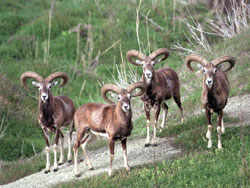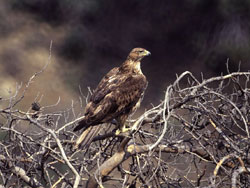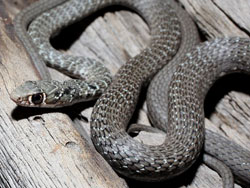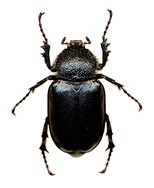|
From the microcosm of its fauna to the larger mammals
The fauna of the region could not be anything but inextricably linked to its flora, habitats and particular ecological conditions. Although large mammals are rare – with the exception of the Moufflon – the Geopark’s fauna is of great ecological value, given the presence of many endemic and endangered species. More than 100 of the total of 265 types of bird found on the island have been recorded in the Park, while all the endemic species are gathered in the area of the Park.
Moreover, 16 of the 30 species of mammals and 13 of the 22 types of reptiles that are found in Cyprus have been recorded in the Park. Equally important is the number of endemic insect species in the area – 107 – and the fact that 8 of the 9 endemic types of butterfly are found in the Troodos Geopark..
The main categories of fauna, with some of their most characteristic types, are the following:
Mammals
 The most important type is the Cyprus Moufflon (Ovis gmelini ophion), which lives in the Paphos Forest and travels as far as the borders of the Troodos National Forest Park. It is followed by the recently-discovered endemic species of mouse (Mus cypriacus), which is found in certain areas of the Park. The hare (Lepus europaeus) and the fox (Vulpes vulpes indutus) are among the mammals found in the habitats of Troodos while various protected species of bat live in old houses, arcades and the galleries of abandoned mines, as well as in old tree hollows. Bats are protected on a national and EU level since their global population is shrinking constantly. The most important type is the Cyprus Moufflon (Ovis gmelini ophion), which lives in the Paphos Forest and travels as far as the borders of the Troodos National Forest Park. It is followed by the recently-discovered endemic species of mouse (Mus cypriacus), which is found in certain areas of the Park. The hare (Lepus europaeus) and the fox (Vulpes vulpes indutus) are among the mammals found in the habitats of Troodos while various protected species of bat live in old houses, arcades and the galleries of abandoned mines, as well as in old tree hollows. Bats are protected on a national and EU level since their global population is shrinking constantly.
 Birds Birds
The ornithological value of the area is reflected in the designation of Special Protection Areas (SPA) for birds. Among the most important species are the Europe-wide endangered Bonelli’s eagle (Hieraaetus fasciatus), the highly endangered griffon vulture (Gyps fulvus) and many other birds of prey such as the northern goshawk, the long-legged buzzard and others. Also, the endemic Cyprus wheatear (Oenanthe cypriaca), the Cyprus warbler (Sylvia melanothorax) and the short-toed tree-creeper (Certhia brachydactyla dorotheae) are found here together with the red crossbill (Loxia curvirostra), the Eurasian wren (Troglodytes troglodytes), the nightingale (Luscinia megarynchos) and the common raven (Corvus corax ), which is in danger of becoming extinct on the island.
Reptiles and Amphibians
 Among these, an important place belongs to the endemic species of Cyprus snake (Coluber cypriensis), the endangered watersnake Natrix natrix which has been recorded at the Xyliatos dam and its vicinity, and the endemic subspecies of lizard Lacerta laevis troodica. The marsh frog (Rana ridibunda) and the green toad (Bufo viridis), which reproduce in flowing rivers are life forms that are essential for the balance of the Troodos ecosystems. In the flowing waters of its rivers one also finds the Cyprus freshwater crab (Potamion potamios cyprius ), an endemic Cypriot subspecies. Among these, an important place belongs to the endemic species of Cyprus snake (Coluber cypriensis), the endangered watersnake Natrix natrix which has been recorded at the Xyliatos dam and its vicinity, and the endemic subspecies of lizard Lacerta laevis troodica. The marsh frog (Rana ridibunda) and the green toad (Bufo viridis), which reproduce in flowing rivers are life forms that are essential for the balance of the Troodos ecosystems. In the flowing waters of its rivers one also finds the Cyprus freshwater crab (Potamion potamios cyprius ), an endemic Cypriot subspecies.
 Insects Insects
In the insect kingdom, pride of place goes to butterflies such as the cardinal (Pandoriana pandora) which is common in the Troodos area, the rare black-veined white (Aporia crataegi) and nettle-tree butterflies (Libythea celtis), the endemic Paphos blue (Glaucopsyche paphos) and the purple hairstreak (Quercusia quercus). Among the strictly protected species noted in the Habitat Directive, the endemic Cyprus beetle (Promomacrus cypriacus) and the Jersey tiger moth (Callimorpha quadripuctaria), popularly known as the Rhodes butterfly, have been recorded here. Although the entire category has not been studied to a satisfactory degree, among the insects recorded in the area are dozens of endemic species.
Other types of fauna
In the area of the Geopark there are other smaller types of fauna that have yet to be studied properly such as, for example, snails of which a study has recently begun and it has already brought to light at least three species that are endemic to Cyprus.
|